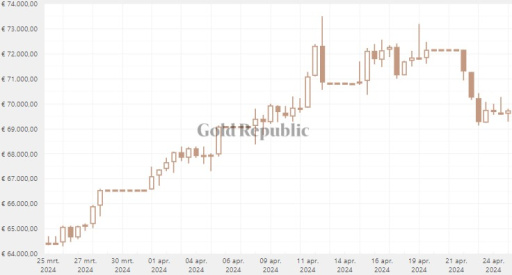Gold falls 3.3% in 4 days - has the price passed its peak?
April 25 2024
►What are the causes of the gold price drop?
►Where is the 'smart money'?
►Correlation between interest rates and gold, still valid?
Decline in Gold Prices
The gold price has experienced a 3.3% decrease since Monday, April 22nd. This correction follows a period of significant growth, during which the price rose by 14.5% in one month (from March 19th to April 19th). The ongoing conflict in the Middle East, particularly Iran’s increasing involvement, has been the main driver behind the recent volatility in gold prices.
Key events, such as the Israeli airstrike on the Iranian embassy in Damascus on April 1st, the major Iranian attack on Israel on April 13th, and statements by the Iranian Foreign Minister on April 19th about not escalating the conflict, have directly influenced the markets.
The news that Iran is not aiming for escalation has brought some 'calm' back to the financial markets, reflected in the decrease in gold prices and an increase in the S&P 500. With a rise of 17.4% since the beginning of the year, gold is performing significantly better than its average annual return since 2001, which is around 9%.

The 'Smart Money'

1. Bond market: $133 trillion (1. USA $51 trillion & 2. China $20.9 trillion)
2. Stock market: $109 trillion (1. USA $46 trillion & 2. Europe $12 trillion)
3. Global savings (estimated): $28 trillion


The bond market holds a significant portion of global wealth, making it a particularly relevant sector. A bond acts as a debt certificate that establishes a contract between the investor (the bondholder) and the debtor (such as a company, bank, or government) for a specified period. When an investor purchases a bond, they receive interest in return. An increase in interest rates makes buying bonds more attractive, which is why this form of investment is especially popular among large pension funds looking for 'low-risk' investments.
The interest received on a 10-year U.S. Treasury bond has been on an upward trajectory since the spring of 2020 and reached a peak of 5% in November 2023 – the highest level since September 2007.
It's evident that the bond market is a formidable competitor to gold. Since gold does not generate interest, bonds, with their increasing returns, become more attractive, which diminishes the demand for gold. However, what happens to the vast money flows when interest rates drop and bonds become less appealing? Imagine if just 5% of this capital, amounting to $6 trillion, were to shift into gold. This would significantly boost the gold price.

Is this time different?
Since the spring of 2020, the interest rate on the 10-year Treasury bond has risen by four percentage points and currently stands at 4.71%. Meanwhile, the gold price has surged by 44%, deviating from the traditional inverse relationship between interest rates and gold prices. Recent history, however, suggests that this may no longer be the case. With the expectation that interest rates will drop in September this year, with a probability of 70.1%, it remains to be seen what this will mean for the gold price.
One thing is certain: we cannot predict the future, and I will not attempt to do so.
It is only wise to be prepared for multiple scenarios. What percentage of your investment portfolio is in gold? This naturally depends on several factors, including your age and risk profile. However, experts suggest that this percentage should be between 1% and 10%.
Disclaimer: The information on this webpage is not considered investment advice or an investment recommendation.